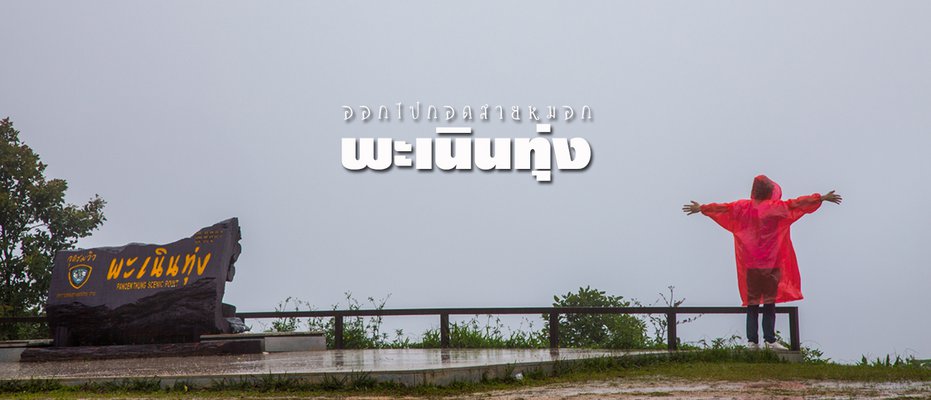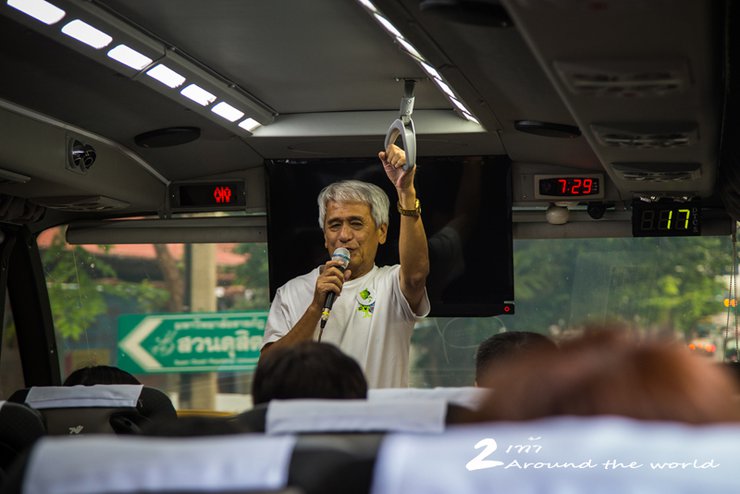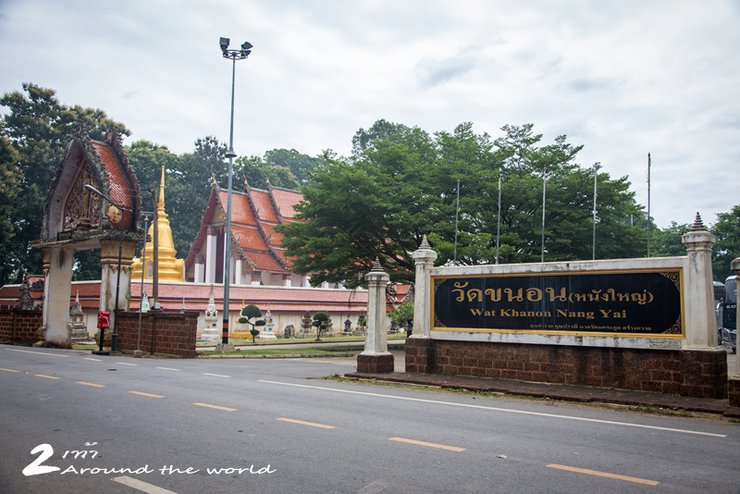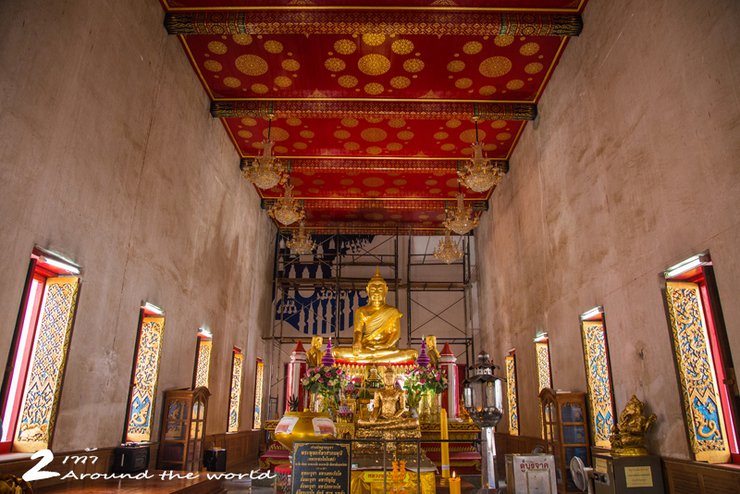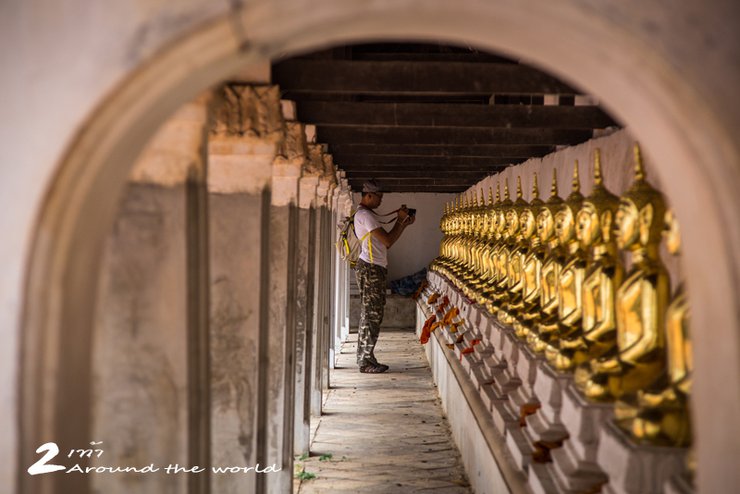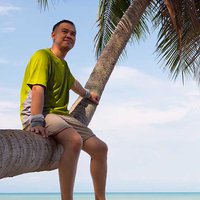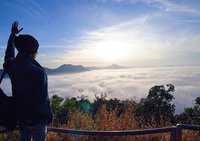
This trip, I had the opportunity to travel with AIS Trip on the project "Hug the Mist at Pha Nen Thung, Phetchaburi: Learn Photography Techniques from Professional Photographers." The main itinerary was in Ratchaburi and Phetchaburi provinces. The instructors were Mr. Nopadol Achasantisuk, Vice President of the Photographic Society of Thailand from 2014 to present, and a photographer who has captured important events in the country's history, and Mr. Somphot Tangthai, a freelance photographer and author of articles on photography and tourism in Camera Art magazine. They provided photography knowledge to all participants. I would like to share my experience with you. AIS Trip has been organized continuously for 5 years now, and this AIS Trip was the 23rd edition.
Members gathered at the AIS 1 building. Once everyone was present, they set off on their journey.

Approximately 30 minutes into the journey, Professor Nopadol provided a brief introduction to photography techniques for the group on the bus. This preliminary guidance aimed to familiarize us with our cameras in preparation for our first photography destination, Wat Khanon in Photharam District, Ratchaburi Province.
It took us about 2 hours to reach "Wat Khanon (Shadow Puppets)". It is estimated that Wat Khanon was built in 1784 AD or perhaps earlier. Originally named "Wat Kanon", the area surrounding the temple was once a dense forest of red wood and rubber trees, providing a habitat for various animals such as tigers, barking deer, deer, monkeys, gibbons, squirrels, and a wide variety of birds. One particularly abundant bird was the crow. During the day, the crows would fly out to find food along the Mae Klong River and return to roost at Wat Khanon. As a result, the villagers called it Wat Kanon. Later, the name was changed to "Wat Khanon Porawas", but the locals still prefer to call it "Wat Khanon".



The must-see attractions of Wat Khanon include three main points. The first is the ordination hall, which resembles the Phra Viharn Luang of Wat Suthat Thepwararam. Inside, there is a sandstone Buddha statue in the attitude of subduing Mara, dating back to the late Ayutthaya to early Rattanakosin period. On the left and right sides are the two chief disciples standing with their hands in a prayer position. Behind the ordination hall, there is a large bell-shaped stupa made of brick and mortar.


The cloister surrounding the ubosot is made of brick and mortar, with arched doorways on all four sides. Inside the cloister, there are 120 Buddha statues in the attitude of subduing Mara, arranged around the satellite stupas.



The second point of interest is the Shadow Puppet Museum at Wat Khanon.


This building houses a collection of shadow puppets, which were gradually created during the reign of King Rama V by Luang Pu Glom. He invited artisans to collaborate on their creation. The first set created was the "Hanuman Offering the Ring" set. Subsequently, eight more sets were created, bringing the total number of puppets to 313.


Phra Khru Pitak Silpakam, the abbot of Wat Khanon, a preserver of shadow puppetry in Thailand, shared the history of shadow puppetry with us.

Subsequently, Professor Nopadol provided guidance on various photography techniques and allowed participants to experiment with capturing images.

After taking the photos, we will check them together. Professor Somphoch will be there to give advice on how to improve the photos.


Most shadow puppets are made from cowhide, which is cut into the shapes of the characters in the story. The most important puppets are the "เจ้า" or "ครู" puppets, which are used in the teacher-worship ceremony. There are three of these puppets: the hermit, Shiva, and Vishnu. The "เจ้า" puppets are made from the hide of a cow that died pregnant, was bitten to death by a tiger, or was struck by lightning. However, if these hides are not available, tiger or bear hide can be used instead. The puppet maker must wear white clothes and observe the eight precepts, and must complete the writing and painting of the puppets within one day. Other puppets are made from cowhide. The puppets on display in the museum are illuminated by light boxes, making their colors appear bright and vivid. While walking around looking at the puppets, I couldn't help but wonder how these puppets, some of which are very old, could look so new. However, if the lights in the display cases are turned off, the age of the puppets becomes clearly visible.

The central figure in the image is the Narayana-on-Garuda shadow puppet, an avatar of Rama. This puppet, crafted from four cowhides, stands at an impressive 3.15 meters tall and was completed in just two days. It is considered the largest shadow puppet in the world.

The old film storage room, as far as the eye can see, seems to contain more than 100 very old films.

The balcony extending from the museum features a sprawling Indian cork tree, offering ample shade. While I cannot confirm its use for shadow puppetry training, televised demonstrations suggest this location serves as a teaching ground for the art form.
The highlight of Wat Khanon is the shadow puppet show at the Wat Khanon Shadow Puppet Theatre. Shows are held every Saturday at 10:00 AM and Sunday at 11:00 AM. Only one show is held per day.






The Enduring Legacy of Nang Yai: A Cultural Treasure of Thailand
Nang Yai, a traditional Thai shadow puppetry, stands as a testament to the nation's rich cultural heritage. Revered as a high art form, it seamlessly blends diverse artistic disciplines, showcasing the intricate beauty of Thai design, the meticulous craftsmanship of woodcarving, and the expressive grace of theatrical performance.
The intricate patterns and motifs adorning the puppets, reminiscent of classical Thai paintings, are a testament to the artistry of Thai design. The delicate carvings, a product of skilled craftsmanship, breathe life into these wooden figures. During performances, the puppets come alive through the skillful manipulation of puppeteers, their movements echoing the emotions and narratives of the stories being told.
Complementing the visual spectacle is a harmonious blend of performing arts elements. The rhythmic melodies of the piphat ensemble, the captivating dialogue and narration, and the evocative singing create a captivating atmosphere, immersing the audience in the unfolding narratives.
Nang Yai transcends mere entertainment, offering a profound artistic experience that engages the senses and stirs the emotions. It serves as a window into Thailand's cultural tapestry, showcasing its artistic prowess and storytelling traditions. As a cultural treasure, Nang Yai continues to captivate audiences and inspire generations, ensuring its enduring legacy for years to come.

Professor Nopadol suggested using a slow shutter speed, around 1/60, to capture the moving filmstrip effect. I took several shots for this image, as my hand was not steady enough.

The enchanting melodies of the piphat ensemble, masterfully performed by these talented young musicians, captivated the audience and elevated their aesthetic experience.
Following the shadow puppet performance, all members participated in a collaborative activity: hammering the leather puppets.





A temple speaker provided guidance on leather stamping, and members enthusiastically showcased their skills. After successfully stamping the plain leather with the desired patterns, they attached it to keychains, completing the process. The temple presented each participant with a self-made leather charm as a souvenir.

At Wat Khanon, we gained knowledge about the history of shadow puppets, learned about photography, enjoyed watching shadow puppet shows, and even got to try our hand at making our own shadow puppets, which we could take home as souvenirs. Everyone seemed to be having a great time. I must say, visiting this place was truly heartwarming.
UNESCO has recognized the "Inheritance and Restoration of Shadow Puppets at Wat Khanon" with an award and has named it one of the six outstanding communities in the world for its work in preserving and reviving intangible cultural heritage. This is a great honor for Wat Khanon. If you are visiting Ratchaburi, I highly recommend visiting Wat Khanon. Plan your visit to coincide with a performance for a truly enriching experience.
A hungry army marches on its stomach. Today, we entrust our stomachs to "Alpaca Restaurant, Ratchaburi."

Although the Alpaca Farm in Ratchaburi is not located on a main road, and accessing it requires passing through a village entrance, as the guide jokingly mentioned, "Let's see how the people of Photharam live," once you arrive at the farm, the village feel disappears completely. The farm's grounds are incredibly spacious, and it even has a conference room inside. It's quite stylish.


The ambiance is inviting, with both air-conditioned and open-air dining options available.

AIS provided excellent service, including a reserved air-conditioned room. I particularly enjoyed the restaurant's ambiance, which featured artistic murals on the brick walls.



The food was truly impressive, featuring a wide variety of dishes such as eight-flavored squid, stir-fried morning glory, tom yum soup, German pork knuckle, spicy pork salad, crab omelet, mixed vegetable stir-fry, black pepper fish, and taro and young coconut dumplings. If I were to compare the three restaurants I visited during my trip in terms of taste, I would award the gold medal to Alpaca Restaurant in Ratchaburi. Both the presentation and the flavor of the food were exceptional in every dish.


Visiting the alpaca farm without seeing the alpacas would be like visiting a zoo without seeing the animals. So, I decided to go see the alpacas. When I saw them, I couldn't help but feel a little envious. All they do all day is walk around looking beautiful for the tourists. Plus, they eat well, live well, and sleep in air-conditioned rooms. In the evening, the farm releases the alpacas into the field to play, but when I arrived, it was the middle of the day and the sun was very hot. So, the farm had brought the alpacas inside to rest in the air conditioning. I thought to myself, "You're comfortable, but I'm the one who has to come see you in the air conditioning. I have to endure the smell of your poop and pee until my nose is completely numb..."


After admiring the alpacas, I took a stroll around the shop to soak in the atmosphere. The interior boasts numerous stylish corners perfect for capturing memorable photos.
The Alpaca Restaurant in Ratchaburi is only 6 kilometers from Wat Khanon. If you are visiting Wat Khanon, I recommend stopping by this restaurant for lunch. You won't be disappointed.
From the Alpaca farm in Ratchaburi, the group traveled to Phetchaburi to practice taking beautiful photos at the Phra Nakhon Khiri Historical Park.


It took us about an hour to reach the Phra Nakhon Khiri Historical Park. AIS provided us with the convenience of taking a cable car up to the top of Khao Wang, which saved us time, energy, and protected the knees of our senior citizens (who are still beautiful and fit for their age). Plus, we didn't have to fight off the monkeys that would try to snatch things from us.

**"Phra Nakhon Khiri Historical Park"**, also known as **"Khao Wang"**, is a prominent landmark of Phetchaburi province. When traveling south through Phetchaburi, Khao Wang stands out prominently atop Khao Khiri, visible from afar.
King Mongkut (Rama IV) desired to build a palace for his summer residence atop Khao Khiri (also known as Khao Saman). He appointed the Deputy Governor of Phetchaburi to oversee the construction, which was completed in 1860. The King bestowed the name "Phra Nakhon Khiri" upon the palace.

The path from the tram station to the palace is quite shady, with trumpet trees providing ample cover.

Officials came to give us a presentation.
Khao Wang Palace is a complex of buildings, including royal residences, temples, and other structures, primarily in a Western neoclassical style with Chinese architectural influences. The palace sits atop three large hills, but I only had time to visit the western peak, where the Phetchaburi Royal Palace is located. This peak houses the royal residences, including the Santhakarn Prasat Throne Hall, the National Museum of Phra Nakhon Khiri, the Wechayan Wichai Prasat Throne Hall, the Ratcha Tham Sabha Throne Hall, and the Ho Chatchawal Wiang Chai.

The Chatchawal Wiangchai Observatory is a two-story circular tower with a curved glass roof. It was built for the purpose of studying and observing astronomy. In the past, during the night, lanterns were lit and hung inside the glass dome. When viewed from the sea, the Chatchawal Wiangchai Observatory could be seen from afar, making it a useful landmark for sailors entering the Bay of Ban Laem.

From the Wachiravalai Pavilion, looking towards the eastern peak, one can see the location of Wat Phra Kaew Noi, or the Little Emerald Buddha Temple. Built as a temple within the royal palace grounds, similar to Wat Phra Kaew in the Grand Palace, it also features the Red Prang, a four-faced chedi painted entirely in red, a chapel, and the Phra Suthat Selajeti, a grey-green marble chedi with a fascinating construction history. The marble was carved on Ko Sichang and then transported by boat to be assembled on this mountain.

The central peak houses the white-colored Phra That Chom Phet Chedi, which was restored by King Mongkut (Rama IV) from an existing ancient stupa. The king also enshrined a relic of the Buddha within the stupa and bestowed upon it the name Phra That Chom Phet.

This vantage point offers a panoramic view of both the eastern and central peaks.

On the western peak, in addition to the Ho Chatchawal Wiangchai, there is also the Phra Thinang Wechayan Wichai Prasat, a small prang-style castle built according to the belief that the construction of a grand palace must include a castle. Inside, there is a statue of King Rama IV in the same attire he wore when receiving foreign ambassadors. However, photography is not permitted inside the building.

From the vantage point of the Wechyan Wichai Prasat Throne Hall, one can gaze upon the cityscape of Phetchaburi, surrounded by an abundance of palm trees. The backdrop of rolling hills completes the picturesque scene.
Unfortunately, my limited time here did not allow me to visit the museum.
It's time for dinner. Tonight, I'm having dinner at "Sea View Seafood Restaurant".



Today, AIS is treating its customers to a seafood feast, with every dish featuring the freshest catches from the sea. From succulent grilled prawns and stir-fried crab in curry powder to succulent scallops, spicy seafood stir-fry, and a medley of seafood salad, the menu is a veritable paradise for seafood lovers. The offerings also include pan-fried sea bass with fish sauce, spicy grouper soup with holy basil, steamed squid with lime, and fresh oysters. Even the fried rice is infused with the delicate flavor of crab. However, for those with seafood allergies, this feast might be a cause for concern.

During the bus ride, Professor Nopadol provided guidance on food photography. He recommended using an aperture of approximately 5.6-11. He also explained that food photography can be captured from two perspectives: top view and diagonal. Each perspective has its own considerations. When shooting from a top view, ensure that the circular plate appears as a perfect circle, not an ellipse. This can be achieved by shooting perpendicular to the plate. For diagonal shots, be mindful of extraneous objects entering the frame.
Upon arriving at the restaurant, each member was more eager to photograph the food than to satisfy their hunger.


Everyone seems to be truly enjoying this meal.
Overall, for View Talay Seafood, I think this restaurant excels in its use of fresh seafood ingredients. However, in terms of taste, I still prefer Alpaka Restaurant in Ratchaburi. Therefore, I would award View Talay Seafood the silver medal.
After dinner, we traveled to our accommodation at "D VAREE NANA KAENG KRACHAN," which took about 1 hour from the View Talay Seafood restaurant.
The group arrived at their accommodation around 7:30 p.m. and immediately began a photography workshop with the two instructors.


The instructor provided comprehensive photography guidance for both DSLR and smartphone cameras, covering aspects such as ISO, white balance, and various shooting modes like P, AV, TV, and M. Additionally, they offered valuable tips on selfie photography, which was highly appreciated by the trip participants.

This AIS Trip surprised two customers with birthday celebrations. I couldn't help but feel goosebumps for the birthday people.

In addition to surprising customers on their birthdays, AIS also surprised everyone from the moment they set off on their journey by giving them a "Nong Aun Jai" doll holding a heart with each person's name embroidered on it.
It's time to rest in my room, as tomorrow we have an appointment to embrace the mist on the top of Pha Nen Thung.
The scene cuts to the resort. Here are some images of the interior of the D VAREE NANA KAENG KRACHAN.


Front view of the resort.

It is simulated as a small waterfall.

The resort is quite spacious and features beautifully landscaped gardens.

Shared swimming pool.

A coffee shop amidst lush greenery, offering a truly serene atmosphere.

Let's take a look at the rooms. The room I stayed in was a long, connected room.

The spacious room features two beds, suggesting a capacity of four guests based on the presence of four pillows and four drinking glasses. However, AIS has assigned two guests per room.

Amenities are quite complete, including an LCD TV, refrigerator, air conditioning, hairdryer, and free Wi-Fi.

A 5-foot bed might be a bit cramped for two people, but it's okay for one person.

In front of the bathroom, there is a table where you can sit and apply makeup or work.

The bathroom is spacious, with a toilet equipped with a bidet spray. A glass partition separates the wet and dry areas.
I will rest well tonight to prepare for my departure tomorrow at 4:45 AM.
This morning marked the highlight of the trip: embracing the mist on the peak of Pha Nen Thung.
Each participant boarded a designated off-road vehicle provided by AIS. The vehicles were four-door pickup trucks with a seating capacity of four passengers in the cabin and six passengers in the rear bed, for a total of ten passengers per vehicle.
Since yesterday, I have been praying that it would not rain during the ascent to Phaneun Thung, as rain could hinder our progress and make it difficult to see the sea of mist. However, this morning, after opening the door to prepare for our departure, I was secretly relieved to find that it was not raining.
As I sat in the back of the pickup truck, I felt the air grow increasingly colder. Though I am not typically bothered by the cold, the prolonged exposure to the wind began to cause me to shiver. Soon, the rain began to fall, adding to the chill and causing the occasional raindrop to splash onto my skin. Fortunately, the truck I was riding in had a relatively well-covered roof, which prevented most of the rain from reaching the back. This was in contrast to many other trucks, which had high roofs but open fronts, allowing the rain to pour directly into the back.
The vehicle navigated through the darkness, leaving me uncertain of the surrounding terrain. The left side could have been a dense forest, while the right, a steep drop. All I knew was that the road ahead was riddled with potholes, causing everyone in the car to sway violently. As we neared our destination, the darkness began to dissipate, revealing the lush expanse of the Kaeng Krachan National Park. The journey from our accommodation to the top of Pa Nen Tung took approximately two hours.
"He Phanein"
This meadow, located within the Kaeng Krachan National Park, sits at an elevation of approximately 1,207 meters above sea level. Due to its lush vegetation, He Phanein offers stunning views of a sea of mist throughout the year, even during the summer months. The mist that forms over He Phanein is a result of the abundant trees releasing carbon dioxide, which then condenses into the beautiful mist that blankets the area.

From the parking lot, we had to walk for about 100 meters to reach the open space that served as the viewpoint for the sea of mist. AIS had thoughtfully provided raincoats for everyone before we set off, and this morning, everyone was putting their raincoats to good use. The atmosphere at the viewpoint was not unlike that of a school sports day.

The rain continued to fall steadily, obscuring the sea of mist before me. Only a thick fog filled the air, limiting visibility and preventing any glimpse of the Kaeng Krachan forest. Despite the lack of a view, I decided to embrace the fog and stand on the scenic viewpoint of Pha Nen Thung, fulfilling my intention to be enveloped by the mist.
After enjoying the rain and mist, I walked back to the Pha Nen Tung Camp, which is not far from the viewpoint, to have breakfast. The resort had prepared a set box for me, along with chicken porridge and steamed buns. AIS also provided coffee.
Despite the relentless drizzle, the time has come to bid farewell to Pha Nen Thung. I depart with the hope of returning to witness the breathtaking sea of mist once again.

As I descended the slope, the sky had already brightened, allowing me to see the scenery along the way from the top of the Phaneung Thung hill to the plains below. Some sections of the path required crossing streams, which added to the excitement and fun of the journey.

As I mentioned earlier, some cars have a raised roof structure, but the front of the roof is open, allowing rain to enter the back fully.


I truly love this spot with the tree tunnel.
The ascent and descent of Phaneun Thung is limited to two rounds per day. The first round is from 5:30 AM to 7:30 AM, and the second round is from 1:00 PM to 3:00 PM. Similarly, the descent from Phaneun Thung is also limited to two rounds per day: the first round is from 9:00 AM to 10:00 AM, and the second round is from 4:00 PM to 5:00 PM. It is recommended to use a pickup truck, preferably a 4x4, for driving up Phaneun Thung. Sedan cars and vans are not permitted on the route. Phaneun Thung is closed for natural restoration from August 1st to October 31st of each year.


Upon reaching the ground level, we will take a short break to visit the Kaeng Krachan Dam area. Afterwards, we will head back to our accommodation to freshen up and collect our belongings before continuing our journey.


For lunch today, I had the pleasure of dining at "Rim Gaeng Restaurant", conveniently located by the Kaeng Krachan Dam. Taking a break from seafood, I opted for some home-style dishes. My meal consisted of fried Nile tilapia, stir-fried fiddlehead fern with oyster sauce, fish steamed in fish sauce, deep-fried fish cakes, sour curry with acacia pennata and shrimp, and stir-fried fish with chili. While the flavors were average, the restaurant's ambiance truly stood out. For the overall experience at Rim Gaeng Restaurant, I award a bronze medal.

Enjoying a meal while taking in the scenic views above the dam. It's amazing!
After a satisfying meal, we continued our journey to The Tea House for an afternoon coffee break.

"The Tea House" will be located at the far end of the FN Outlet in Cha-am.

The provided text is empty. There is nothing to translate.
AIS allows all customers to choose their own drinks and snacks.


The presentation of each beverage and the decoration of each snack were so visually appealing that I couldn't resist taking out my camera to capture the moment. It was time to put the food photography skills I learned from Professor Nopadol to good use. I noticed that some members were still busy taking photos of their snacks even after I had finished photographing and eating mine.




The Tea House is designed to be a French-style tea shop. The most striking feature is the large, intricately carved wooden door from India, which is located behind the counter.

This charming spot offers more than just stunning photo opportunities to impress your friends. Indulge in refreshing drinks and delectable snacks while enjoying the soothing sounds of a saxophone. It's an unforgettable experience! If you're ever in the Cha-am or Hua Hin area, be sure to check out The Tea House.
The AIS Trip "Hugging the Mist at Pha Nen Tung, Phetchaburi" has come to a successful conclusion. Initially, I was hesitant about the 3,500 baht price tag, considering the trip's focus on Ratchaburi and Phetchaburi provinces. I estimated that self-planned travel wouldn't exceed 2,000 baht. However, my perspective shifted dramatically after experiencing the trip firsthand. The cost of three meals and one night's accommodation alone surpassed the 3,500 baht value. Additionally, the exceptional care from AIS, the camaraderie among fellow travelers, the photography knowledge gained, and the historical insights into the visited locations were invaluable bonuses. The AIS Trip is a commendable initiative by AIS, offering exceptional value to its customers.

Read the messages in the LINE group where each trip participant expressed their feelings about the trip. It might inspire your friends to have a similar positive experience. If you're interested in this type of activity, you can follow the news at http://aistrip.ais.co.th/
ลุงเสื้อเขียว
Tuesday, October 8, 2024 11:24 AM




